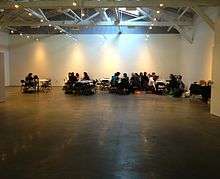Wattis Institute for Contemporary Arts

The Wattis Institute for Contemporary Arts is a contemporary art center in San Francisco, California, United States and part of the California College of the Arts. The Wattis Institute was established in 1998 to serve as a forum for the presentation and discussion of international contemporary art and curatorial practise and a premiere venue for contemporary art exhibitions worldwide. Through exhibitions, lectures, symposia, and publications, along with its residency program, Wattis has become one of the leading art institutions in the United States and provides an active site for contemporary culture in the San Francisco Bay Area.[1] The local impact is equally important and the Wattis Institute is central to the vitality of the Bay Area art scene. Local residents and visitors come to the Wattis Institute to see the best work of emerging artists, as well as new work by established artists, and can attend any program free of charge.
Location and design
The Wattis Institute was originally located on the San Francisco campus of the California College of the Arts at the bottom of Potrero Hill in a refurbished 160,000-square-foot (15,000 m2) former Greyhound Bus maintenance facility designed in 1951 by Skidmore, Owings and Merrill. Wattis opened its new location at 360 Kansas Street in January 2013. The facility was redesigned by architect Mark Jensen, best known for his work with the Rooftop Garden at the San Francisco Museum of Modern Art.[2]
Founding and leadership
The Wattis Institute is named after Phyllis C. Wattis one of San Francisco's greatest supporters of the arts who died in June 2002 at the age of 97. During her lifetime, she supported many art organizations in San Francisco and the Bay Area. She served on the board of the San Francisco Museum of Modern Art, the de Young Museum, the San Francisco Symphony and the San Francisco Opera and was as much an ideological as financial supporter of these organizations. Her vision helped to shape the art community of San Francisco to be one of the most active and most cutting edge.
Lawrence Rinder was the founding director of the Institute. The current director is Anthony Huberman, who replaced Jens Hoffmann in 2013.
Capp Street Project
The Wattis Institute also runs the pioneering Capp Street Project. Founded in San Francisco in 1983, it is the first visual arts residency in the United States dedicated solely to the creation and presentation of new art installations. Since its inception, the Capp Street Project has given more than 100 local, national, and international artists the opportunity to create new work through its residency and public exhibition programs.[3]
References
- ↑ "CCA Wattis Institute for Contemporary Arts". NewMuseum.org. New Museum Of Contemporary Art. 2013. Retrieved 2014-07-27.
- ↑ Cascone, Sarah (2012-12-17). "CCA Wattis Opens New Space". Art In America. Art In America. Retrieved 2014-07-27.
- ↑ "Capp Street Project". Wattis.org. CCA Wattis Institute for Contemporary Arts. n.d. Retrieved 2014-07-27.
External links
Coordinates: 37°46′02″N 122°24′00″W / 37.767160°N 122.400046°W